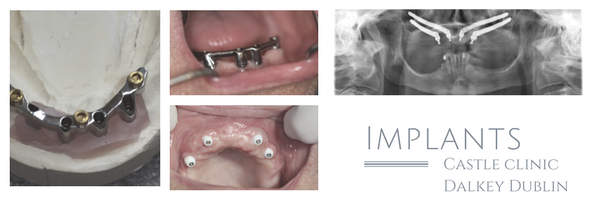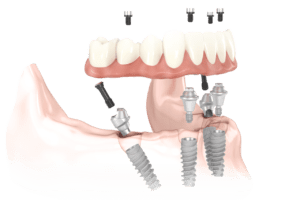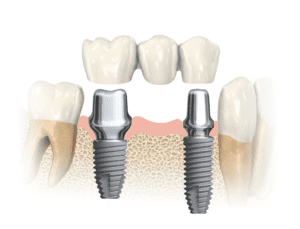
Single Tooth Implant
Learn More
What is a dental implant? – A dental implant is essentially a substitute for a natural root and commonly it is screw or cylinder shaped. Almost all dental implants are made from titanium although we also offer placement of zirconium ceramic implants “Nobel Pearl’. Implants are placed into carefully prepared sockets at the precise location of the intended tooth. The main aim during placement of any implant is to achieve immediate close contact with the surrounding bone. This creates an initial stability, which over time is steadily enhanced by further growth of bone onto the microscopic roughness on the implant surface. In order to support replacement teeth, dental implants normally have some form of internal screw thread or post space that allows a variety of components to be fitted. Once fitted, these components provide the foundation for long-term support of crowns, bridges or dentures

Can implants always be used to replace missing teeth? – It depends on the condition of the bone in your jaw. Your surgeon will arrange for a number of special tests to find out the amount of bone still there. If there is not enough, or if it isn’t healthy enough, it may not be possible to place implants without grafting bone into the area first.
How long will implants last? – Once the implants and surrounding soft tissues are seen to be healthy and the new teeth comfortable and correctly adjusted, it is the quality of your home care and willingness to present for regular maintenance reviews that will have most influence on how long your implants will last. Well-maintained implants placed into adequate bone can be expected to last for many years. You would expect conventional crowns, bridges and fillings to need occasional repairs or replacements during their lifetime. Implant-supported teeth will have a similar maintenance requirement.
How many teeth can be supported by implants? – If you are missing just one natural tooth, then one implant is normally all that will be needed to provide a replacement. Larger spaces created by two, three or more missing teeth do not necessarily need one implant per tooth, however the exact number of implants will depend upon the quality and volume of bone at each potential implant site.
What happens during the placement of a dental implant? – Treatment is normally divided into two or three stages, each of which may involve several visits.
Pre-operative assessment – Before implants can be placed, X-rays and and on occasions conventional or digital impressions of your mouth will be needed. These allow your surgeon to plan the best way to treat you. We also plan using DTX software a virtual planning programme.
Surgical treatment – The next stage of your treatment is to insert the implants. This is normally done under local anaesthetic (an injection which makes the area where we are working numb) by lifting the gum away from the underlying bone, then gently and carefully preparing the jaw bone. The implant is inserted into the bone and the gum replaced and held together with some stitches. Following insertion, some types of implant will stick out through the gum, whilst other types will be buried underneath the gum. The implants will usually be left for at least three months before they are used to support replacement teeth. Implants buried under the gum will require a second small surgical procedure to expose them before they can be used.
Restorative treatment – You will need a number of appointments to make your crowns, bridges or implant denture. This will include taking (digital) impressions and checking the fit of the parts used to make your replacement teeth. In total, treatment could extend over three to twelve months depending on the case.
What are the risks? – There is a small risk that the implants may not fuse properly with the bone in your mouth and so cannot be used. The risk is higher in certain individuals, particularly those who smoke, and you will be advised if the risk of failure is higher than normal in your case. Implant placement involves surgery in your mouth and so may be followed by some soreness, swelling, bleeding or bruising. Any discomfort is usually controlled with simple painkillers (e.g paracetamol and ibuprofen) and should only last a few days. It is possible for parts of your implants to loosen or wear out with time. This can lead to failure of the implant, or the restoration on the implant, if not treated quickly.
If you do not have enough bone what can be done? – For some people, bone loss after the removal or loss of teeth leaves them without enough to secure an implant. In this case there are a number of options which may be suitable and can be discussed with your implant surgeon.
Sinus Augmentation – In the upper jaw above the back teeth, it is possible to increase the height of bone available by creating new bone in the sinus. This procedure is called a ‘sinus augmentation’. We are one of the few practices in Ireland undertaking sinus augmentation.
Bone grafting – There are many ways in which bone can be added to, however one simple concept is to take a piece of bone from somewhere else and secure it as an ‘onlay graft’ to a deficient area. The new piece of bone will slowly join to the underlying region and when healed and mature, an implant can be placed in a more favourable position. The other method called Guided Bone Generation involves using bovine bone chips and mixing with some of your own bone to replace the missing bone and can take four to six months to become ready for implant placement.
Please click on this link for further information including pictures.

All-on-4 Zygoma
Learn More
In some cases there is insufficient bone quantity and poor bone quality after years of denture wearing to place dental implants. Zygomatic implants can provide a solution allowing permanent teeth by placing longer implants in the mouth up to the cheek bone. Sometimes two Zygomatic implants are placed with two normal implants in the front of the upper jaw bone. For very advanced bone loss cases – 4 Zygomatic implants are placed, This is called a ‘Quad Zygoma’.
Patient benefits using Zygoma and Quad Zygoma solutions are:-
- Improved appearance.
- Normal looking teeth and gums.
- Freedom to eat what you like.
- Confidence to laugh.
- Teeth that do not come out.
- no more denture sore spots.
- Long-term tooth support.
- Faster healing than bone grafting.
- Low maintenance.
Please click on this link for more patient information including photographs and x-rays.

Implant Over Denture
Learn More
 At Castle Clinic we specialise in implant retained over-dentures. Dental implants offer edentulous patients comfort and stability when eating and speaking. Usually patients present having had dentures for many years. As a result of normal progressive bone loss in the jaw bones, their once existing comfortable and well fitting dentures become very uncomfortable. Despite getting several new dentures they cannot achieve the comfort they once had. That’s were dental implants come in as a treatment option offering support, retention and comfort.
At Castle Clinic we specialise in implant retained over-dentures. Dental implants offer edentulous patients comfort and stability when eating and speaking. Usually patients present having had dentures for many years. As a result of normal progressive bone loss in the jaw bones, their once existing comfortable and well fitting dentures become very uncomfortable. Despite getting several new dentures they cannot achieve the comfort they once had. That’s were dental implants come in as a treatment option offering support, retention and comfort.
The simplest solution for the lower jaw is two dental implants. The attachments can be locator attachments, the gold attachments on the left picture above. Alternatively a cast bar can be made connecting the two implants with a clasp in the denture that clips onto the cast bar. Three implants and a cast bar is also a possibility offering more retention and resistance to lateral movements of the denture. All-on-4, four dental implants, if adequate bone quantity and quality allows, can be undertaken with a milled titanium bar with locators as on the first picture above or on a cast bar like the the top middle photograph. The over denture option with implants is removable.
If a fixed permanent solution is preferred then ‘All-on-4’ is the preferred approach as shown in the middle bottom photograph above. It is possible to have a fixed implant bridge despite having had dentures for decades.
The minimum number of implants for the upper jaw for an implant over denture is four.
Many patients in Ireland have been assessed by dentists and indeed some dentists working in implant clinics and told they are not suitable for dental implants. We would like to tell you directly that there is an implant solution for most cases. The above x-ray on the left shows an implant solution for a patient with no bone unable to wear dentures after 30 years of denture wearing. Treatment involved four zygomatic implants and a fixed implant bridge. Life changing.
If you have had dentures for years or you are about the get dentures for the first time contact us to arrange a consultation on dental implant solutions. We will talk you through all the treatment options available.

'All-on-4'
Learn More
All-on-4 is a concept that has being around for decades. It allows you to get a completely new and permanent set of teeth in a relatively short time frame. It is a cost effective way to restore the upper and lower dental arches using only four dental implants with special connectors called ‘Multi-unit’ abutments. Castle Clinic is a Nobel Biocare appointed Specialist Centre of Excellence providing ‘All-on-4’ solutions.
Please click on this link for more patient information on Nobel Biocare ‘All-on-4’ at Castle Clinic Dalkey.


Dental Implant Bridge
Learn More
The Dental Implant bridge is a great option to replace several teeth on just a few dental implants. It can be used to restore missing back teeth restoring your bite and avoiding the need to wear a denture. It can also be used to replace missing front teeth giving you your smile back and maintaining your existing healthy back teeth.
Please click on this link for more information on the dental implant bridge option at Castle Clinic Dalkey.


X-Guided Implant Surgery
Learn More
‘X-Guided’ dental implant surgery is new and allows real time surgical guidance when placing a dental implant. This is especially useful in the posterior jaw to aid location of the nerve that runs within the jaw bone allowing safe implant surgery. It is also useful in the upper jaw aiding localisation of the position of the sinus.
For more information on X-Guided surgery at the Castle Clinic please click on this link.
